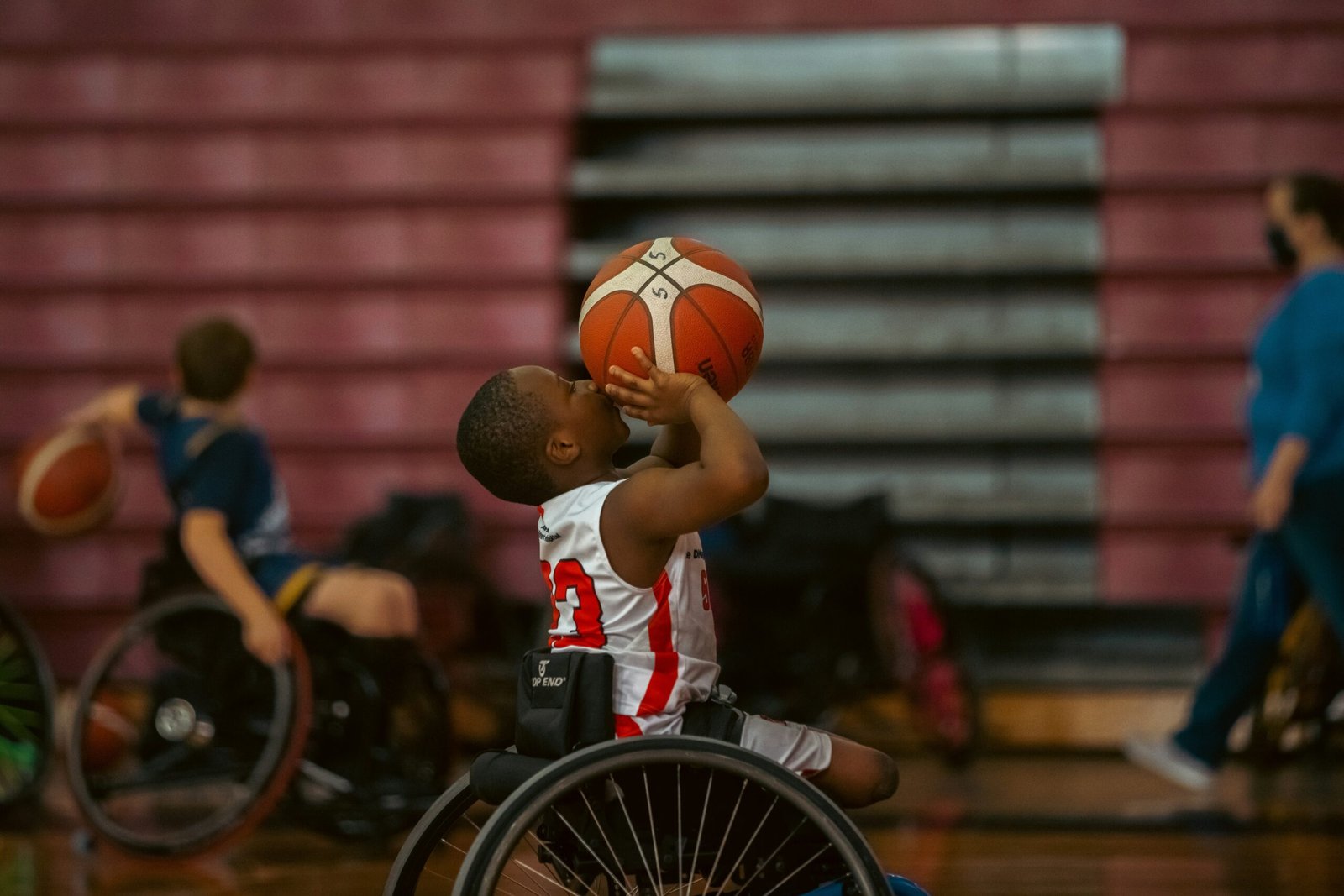
Photo by Moses Malik Roldan on Unsplash
Introduction to Wheelchair Basketball
Wheelchair basketball is a dynamic and highly competitive sport that has captured the hearts of many, not only for its athleticism but also for its inclusive nature. Originating shortly after World War II, wheelchair basketball was first developed as a means of rehabilitation for injured veterans. It quickly evolved into an organized sport, with the first formal games being played in the mid-1940s. The sport’s growth paralleled the development of the Paralympic movement, contributing to its recognition on an international platform.
The rules of wheelchair basketball are similar to those of the traditional game, with a few adaptations to accommodate the players’ use of wheelchairs. The court dimensions, hoop height, and game duration remain consistent with able-bodied basketball. However, specific modifications ensure the sport’s fairness and accessibility. For instance, players must complete dribbling within two pushes of their wheelchair, adding a unique strategic element to the game. Additionally, teams are classified based on the players’ levels of disabilities, with a point system ensuring balanced team compositions.
One of the most remarkable aspects of wheelchair basketball is its inclusivity. The sport is designed for athletes with various lower limb disabilities, including spinal cord injuries, amputations, and other mobility impairments. This inclusiveness fosters a sense of community and provides an opportunity for athletes to compete at both recreational and professional levels. Over the decades, the sport has seen significant advancements, including the development of specialized wheelchairs and training programs, further enhancing the performance and safety of the athletes.
As a staple of the Paralympic Games since 1960, wheelchair basketball continues to inspire and challenge perceptions, demonstrating that physical limitations do not hinder competitive excellence or sportsmanship. The sport’s rich history and ongoing evolution make it a critical part of the global athletic narrative, promoting values of determination, innovation, and inclusivity.
Historical Milestones
Wheelchair basketball boasts a rich history replete with significant milestones that have played a crucial role in shaping its growth and popularity. This adaptive sport emerged in the post-World War II era, primarily as a rehabilitation method for injured veterans. However, it quickly evolved into a competitive activity, culminating in its inclusion in the inaugural International Stoke Mandeville Games in 1948, a precursor to the Paralympic Games.
The 1960 Paralympic Games in Rome marked a pivotal moment for wheelchair basketball as it made its first official appearance on the international stage for men. This inclusion not only paved the way for broader recognition but also provided a structured competitive platform that spurred the sport’s development. Eight years later, in 1968, women joined the ranks, making their debut at the Tel Aviv Paralympic Games. This milestone was significant in promoting gender equality within the sport and encouraging more women to participate.
Over the following decades, several pioneering athletes emerged, leaving an indelible mark on wheelchair basketball. One such figure is Dr. Timothy Nugent, often regarded as the founding father of wheelchair sports. His efforts in establishing the National Wheelchair Basketball Association (NWBA) in 1949 laid the groundwork for organized competition in the United States.
Moreover, the sport witnessed landmark moments that showcased its growing popularity and competitive spirit. Notable instances include the 1960 Paralympic victory of the USA Men’s Team, which set a high standard for future competitions. Another significant achievement was the dominance of the Australian “Rollers” Men’s Team in the 1990s, winning multiple World Championships and Paralympic titles.
These historical milestones depict the journey of wheelchair basketball from a rehabilitation activity to a highly competitive sport with a global following. The continued evolution and recognition of the sport underscore its significance and the profound impact it has on athletes and fans worldwide.
Wheelchair basketball, since its inception, has undergone substantial evolution in various aspects including rules, equipment, and competitive strategies. Initially developed to provide rehabilitative sports options for World War II veterans, the game has morphed into a high-energy, competitive sport with a well-defined set of regulations. Over the years, the most significant changes have been observed in the areas of wheelchair technology, training methodologies, and gameplay tactics.
Rules and Regulations Evolution
One of the most crucial areas of evolution in wheelchair basketball has been the refinement of rules. Initially, the sport borrowed heavily from able-bodied basketball, but over time, specialized rules specific to wheelchair basketball were introduced. The classification system, which assigns players points based on their functional abilities from 1.0 to 4.5, is a key rule that ensures balanced competition. Furthermore, modifications such as the ‘no double-dribble’ rule and the regulations around carrying the ball have tailored the gameplay to fit the unique needs and capabilities of athletes using wheelchairs.
Advancements in Wheelchair Technology
The evolution of wheelchair technology has been another pivotal factor in the growth of wheelchair basketball. Early wheelchairs were often cumbersome and ill-suited for the fast-paced demands of the sport. However, modern wheelchairs are lightweight, highly maneuverable, and engineered for speed and agility. These technological advancements have dramatically improved the game’s pace and the athletes’ performance. Customizable features such as camber angles, specialized seating, and advanced materials like titanium and carbon fiber are now standard, enabling players to maximize their potential on the court.
Training and Competitive Strategies
Parallel to these technological advancements, training methods for wheelchair basketball players have seen significant improvement. Modern training regimes are highly specialized and include a mix of cardiovascular conditioning, strength training, and tactical drills. Coaches increasingly adopt sports science principles to enhance performance, focusing on areas like muscle memory, nutrition, and psychological readiness. This meticulous training approach has resulted in athletes who are more skilled, fitter, and better prepared for competitive play.
The evolution of these elements has collectively revolutionized wheelchair basketball, turning it into a dynamic, strategy-rich sport that continues to gain recognition and respect globally. The ongoing advancements ensure that both the sport and its athletes continuously strive for new levels of excellence and competitive edge.
Notable Players and Teams
Wheelchair basketball, a sport rich in history and competitive spirit, has seen many remarkable athletes and teams rise to prominence. These individuals and squads have not only excelled on the court but have also significantly contributed to the growth and recognition of the sport globally. Their unique playing styles, dedication, and achievements continue to inspire new generations of players.
One of the most iconic figures in the history of wheelchair basketball is Patrick Anderson of Canada. Renowned for his exceptional athleticism and court vision, Anderson has been a dominant force in international competition. His ability to score, pass, and defend with unparalleled skill has made him a standout player. Anderson’s contributions were instrumental in leading Canada to multiple gold medals at the Paralympic Games, cementing his legacy as one of the greatest wheelchair basketball players of all time.
Another notable figure is Annika Zeyen from Germany. Zeyen’s versatility and performance have been a cornerstone of the German team’s success. She played a pivotal role in Germany’s gold medal win at the London 2012 Paralympic Games. Zeyen’s dedication to the sport and her ability to adapt to different positions on the court exemplify the resilience and skill that wheelchair basketball demands.
In the realm of teams, the United States men’s and women’s wheelchair basketball teams are historically significant. The U.S. teams have consistently been at the top of international rankings, showcasing depth, tactical prowess, and extraordinary talent. The men’s team has secured multiple Paralympic gold medals, with their performances highlighting the strategic evolution of the sport. Similarly, the women’s team has demonstrated immense skill and tenacity, contributing to the sport’s popularity and competitive standard.
The role of these notable players and teams in the fabric of wheelchair basketball cannot be overstated. Their achievements and styles play a crucial part in the sport’s history, offering a blueprint of excellence and determination for future athletes to follow. Through their efforts, wheelchair basketball continues to captivate audiences and inspire a new generation of players worldwide.
Challenges and Triumphs
Wheelchair basketball, akin to many adaptive sports, presents a unique set of challenges for its athletes. Accessibility remains one of the primary obstacles that players must confront. Unlike conventional sports facilities, venues suitable for wheelchair basketball require specific adaptations, including ramps, wider doorways, and specialized seating arrangements. These modifications, though essential, often come with significant financial implications, thereby limiting access to adequate training venues for many athletes.
Funding is another prevalent challenge within the world of wheelchair basketball. Equipment such as specialized sports wheelchairs can be costly, with prices often reaching thousands of dollars. Additionally, travel expenses for national and international competitions further compound the financial burdens faced by athletes and teams. Many players rely on sponsorships and grants to support their careers, but securing these funds can be highly competitive and uncertain.
Societal perceptions also play a critical role in shaping the experience of wheelchair basketball athletes. Prevalent stereotypes and misconceptions about disabilities can lead to underestimation of the athletes’ abilities and achievements. Despite the growing visibility of adaptive sports, there remains a significant gap in mainstream recognition and media coverage, further perpetuating such biases. Overcoming these societal barriers requires continuous advocacy and awareness-raising efforts.
Despite these challenges, the resilience and triumphs witnessed in wheelchair basketball are truly inspiring. Athletes across the globe have shared stories of overcoming both physical and societal barriers to excel in their sport. For instance, many have transitioned from rehabilitation to competitive sports, turning personal adversities into powerful motivations. These narratives not only highlight individual perseverance but also underscore the communal support within the wheelchair basketball community.
Additionally, the successes achieved by teams in international tournaments have propelled wheelchair basketball into the global sporting arena, gradually shifting perceptions and increasing acceptance. Each victory, whether on the court or through breaking stereotypes, significantly contributes to the sport’s growth and the empowerment of its athletes.
The Role of International Organizations
International organizations such as the International Wheelchair Basketball Federation (IWBF) and the International Paralympic Committee (IPC) play a pivotal role in the development and governance of wheelchair basketball. These organizations have diligently worked to ensure that this sport receives the recognition and support it deserves globally.
The IWBF is primarily responsible for overseeing competitions, establishing rules, and promoting wheelchair basketball worldwide. By organizing international tournaments such as the Wheelchair Basketball World Championships, it fosters competitive spirit and provides a platform for athletes to showcase their talents. The IWBF also sets classification guidelines to ensure fair play, which are crucial for maintaining the integrity of the sport.
Complementing the efforts of the IWBF, the IPC plays a broader role in the Paralympic movement, with wheelchair basketball being one of the most prominent sports under its umbrella. The IPC works on enhancing the visibility of the sport through its inclusion in events such as the Paralympic Games. By doing so, it helps in drawing attention to the athletes’ remarkable prowess and the strategic depth of wheelchair basketball.
Both the IWBF and IPC have instituted multiple initiatives aimed at supporting athletes through training programs and scholarships. They collaborate with national bodies to create inclusive environments, enabling the sport’s growth at grassroots levels. This includes working on accessibility in sports infrastructure and advocating for policies that support the integration of athletes with disabilities.
These organizations also leverage partnerships with corporations and media to amplify the reach of wheelchair basketball. Sponsorship deals and media coverage not only provide financial backing but also contribute to raising awareness and inspiring a new generation of athletes. The unrelenting efforts of the IWBF and IPC ensure wheelchair basketball continues to thrive, expanding its presence and influence across the globe.
Impact on the Paralympic Movement
Wheelchair basketball has played a pivotal role in the broader Paralympic movement, significantly influencing how Paralympic sports are perceived and experienced globally. Through its dynamic nature and competitive spirit, wheelchair basketball has become a cornerstone in raising awareness for Paralympic sports. This sport’s visibility has provided a robust platform to showcase the athletic prowess of individuals with disabilities, challenging societal stereotypes and altering perceptions about physical limitations and adaptability.
The influence of wheelchair basketball extends far beyond the court. By consistently drawing large audiences and media coverage, it has facilitated greater exposure for other Paralympic sports. This heightened visibility is crucial as it attracts sponsorships, funding, and essential resources that are often directed towards enhancing training facilities, athletic programs, and support services for Paralympic athletes. In doing so, the sport has not only helped to elevate the profile of athletes with disabilities but has also underscored the importance of inclusivity within the sports community.
Furthermore, wheelchair basketball has become an emblem of resilience and determination, inspiring countless individuals across the globe. It has become a medium through which stories of triumph and perseverance are shared, fostering a more inclusive society. The sport’s influence is evident in various initiatives aimed at integrating individuals with disabilities into mainstream activities, whether in sports, education, or employment. This cultural shift towards inclusivity is a testament to the profound impact that wheelchair basketball and the Paralympic movement have had on societal attitudes.
As a result, the narrative surrounding disabilities and athleticism has transformed, highlighting capabilities rather than limitations. This transformation is not merely symbolic; it has practical implications, enabling better accessibility, policy changes, and increased opportunities for individuals with disabilities. Indeed, the ripple effect of wheelchair basketball continues to resonate, reinforcing the significance of the Paralympic movement in promoting equality and inclusivity worldwide.
Future Prospects
As wheelchair basketball continues to evolve, its future prospects appear promising, fueled by technological advancements, evolving regulations, and an expanding global fan base. In the realm of technology, the continued development of lightweight materials and sophisticated design is likely to enhance both the performance and safety of wheelchairs. Innovations such as smart wheelchairs, equipped with sensors to monitor players’ physical conditions and optimize gameplay strategies, may also contribute to significant improvements in the sport.
Additionally, the governance of wheelchair basketball may witness changes to adapt to the dynamic nature of the sport. Potential rule modifications, aimed at ensuring a more inclusive and competitive environment, could be introduced. These changes might include adjustments in classification systems or updates to game regulations to better align with the physical capabilities of players, thus fostering an equitable playing field.
The growth of wheelchair basketball at grassroots levels has seen substantial momentum, spearheaded by increased accessibility to sports facilities and community engagement programs. School and community-based initiatives are essential in identifying and nurturing young talent, thereby creating a robust pipeline of future athletes. Grassroots development is crucial, not only for discovering new talent but also for cultivating a broader appreciation for the sport’s unique challenges and triumphs.
On an elite level, the increasing visibility of wheelchair basketball through global events, such as the Paralympic Games, has significantly contributed to its popularity. Media coverage and sponsorship deals are projected to rise, attracting a wider audience and more substantial investment. This heightened attention can lead to greater opportunities for professional players and more competitive international tournaments, further cementing the sport’s status on the global stage.
In conclusion, the future of wheelchair basketball holds tremendous potential. Through technological innovation, regulatory evolution, and growing international presence, the sport is poised to achieve new heights and garner a more diverse and engaged audience. By harnessing these factors, wheelchair basketball can continue to inspire and empower individuals worldwide.


More Stories
Avani Lekhara: The Journey of an Indian Paralympian Rifle Shooter Who Conquered the World